National Airlines (1934)
| National Airlines | |
|---|---|
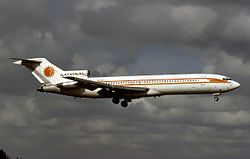
|
|
| IATA code : | N / A |
| ICAO code : | N / A |
| Call sign : | NATIONAL |
| Founding: | 1934 |
| Operation stopped: | 1980 |
| Merged with: | Pan American World Airways |
| Seat: |
Miami , Florida , United States |
| Home airport : | Miami International Airport |
| Management: | Lewis Bergman Maytag |
| Number of employees: | approx. 7800 (April 1979) |
| Fleet size: | 56 (April 1979) |
| Aims: | nationally including San Juan and internationally to Amsterdam , Frankfurt , London , Paris and Zurich |
| National Airlines merged with Pan American World Airways in 1980 . The information in italics relates to the last status before the takeover. | |
National Airlines (until 1937 National Airlines System ) was an American scheduled airline based at Miami International Airport , which was bought by Pan American World Airways in 1979 and merged with them in January 1980.
history
1930s
As a result of the airmail scandal , the US Postal Service's contracts of carriage were rewritten in the summer of 1934. To participate in the award, George T. Baker founded in Saint Petersburg ( Florida -based) airline National Airlines System . The company was awarded the contract for the state mail flights from Saint Petersburg to Daytona Beach and began operations on October 15, 1934 with two Ryan Brougham machines . From May 1935 passenger flights from Saint Petersburg via Tampa , Sarasota and Fort Myers to Miami with three-engine Stinson SM-6000 took place . The company was renamed National Airlines on July 8, 1937 . At that time she flew from Saint Petersburg to eight destinations in Florida with machines of the types Stinson Model U and Lockheed Model 10 Electra . In 1938, a line route from Jacksonville to New Orleans ( Louisiana ) was opened, which ran via Tallahassee , Pensacola , Mobile ( Alabama ) and Gulfport ( Mississippi ). National Airlines moved the operational base and headquarters to Jacksonville the following year. Shortly thereafter, the company offered continuous connections from Miami to New Orleans. The route was called "The Buccaneer Route" .
1940s
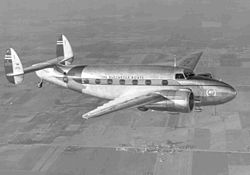
The first Lockheed Model 18 Lodestar joined the fleet in 1940. Until the USA entered the war in December 1941, the route network was no longer expanded. During the Second World War , the company also performed military supply flights for the Air Transport Command and also trained pilots, mechanics and navigators for the US armed forces. The US Civil Aeronautics Board granted National Airlines route rights from Jacksonville to New York in February 1944 , making it a competitor to Eastern Air Lines , which until then had a monopoly in scheduled air traffic between New York and Florida. The route to New York was flown with stopovers in Savannah , Charleston , Wilmington , Norfolk and Philadelphia .
In February 1946, National Airlines took over their first two brand new Douglas DC-4s , with which they operated direct flights between Miami and New York from February 14, 1946. The place of business was relocated to Miami in June 1946. In the same year, the company set up direct connections from Tampa and Jacksonville to New Orleans as well as its first international line route from Miami to Havana ( Cuba ). The first of three initially ordered Douglas DC-6s was taken over by the manufacturer in April 1947. With these machines National Airlines flew the route from Miami to New York from July 1, 1947 in a direct line over water (referred to as the "Great Circle Route" ), whereby the flight time could be shortened from five and a half to four hours.
1950s

After the commissioning of further Douglas DC-6s, the company started offering scheduled flights for vacationers from New York to Florida from 1950 onwards, known as "Air Coach" , on which they reduced prices by a third. National Airlines increased their load factor significantly and generated a profit of $ 500,000 in the same fiscal year. After the shipping company WR Grace and Company acquired a stake in the company in 1949, a collaboration with the South America- based US airline Pan American-Grace Airways ( Panagra ), half of which is WR Grace and Company belonged. Because Panagra did not have its own route rights for flights to New York, National Airlines pilots from Miami took over the service on their planes and flew them on to New York. In the opposite direction, passengers with National Airlines could use Panagra's scheduled flights to travel on to South America.
The first Convair CV-340 and Douglas DC-7 were added to the fleet in September and December 1953, respectively. In November 1953, the company was the first major US scheduled airline to put a Sikorsky S-55 helicopter into service, with which it offered charter services from Miami Airport and shuttle services to neighboring cities until February 1, 1954, among other things Miami Beach , Fort Lauderdale and West Palm Beach . In 1954, the company took direct flights between New York and Havana. Two years later the line network was expanded from Miami to Boston and Houston . The first Lockheed L-1049H Constellation was delivered in September 1957.
The company's fleet in the spring of 1958 consisted of twelve Convair CV-340s, six Convair CV-440s , twelve Douglas DC-6s, three Douglas DC-7s, four Lockheed L-1049 Constellations and nine Lockheed 18 Lodestars . From December 10, 1958, National Airlines deployed a Pan Am leased Boeing 707-120 between Miami and New York, becoming the first company to operate a jet aircraft in domestic US traffic. The first turboprop aircraft of the type Lockheed L-188 was delivered on April 1, 1959 to the company.
1960s
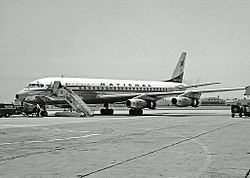
National Airlines took over its first Douglas DC-8-21 from the manufacturer on February 7, 1960. Transcontinental scheduled flights from Miami via Houston to San Francisco and via Houston to Los Angeles and San Diego began on March 11, 1961. In the same year the company had to cease its connections to Cuba for political reasons .
On April 26, 1962, Lewis Bergman Maytag, who was previously a major shareholder in Frontier Airlines , acquired a majority stake in the company and replaced company founder George T. Baker as managing director. National Airlines put its last Douglas DC-7 out of service in the fall of 1964, making it the first US scheduled airline to stop using piston-engine aircraft. The fleet at that time consisted of Douglas DC-8 and Lockheed L-188 aircraft. The first Boeing 727-100 was delivered to the company on October 23, 1964. In September 1967 National Airlines sold their seventeen Lockheed L-188s to aircraft dealer Pan-Aero International Corporation . The machines were gradually transferred to the buyer and replaced by twenty-five Boeing 727-200s . The delivery of the first Boeing 727-200 took place on December 12, 1967. This aircraft was also the first to sport the new color scheme with the company logo known as the "Sun King" . With the retirement of their last Lockheed L-188 on April 21, 1968, National Airlines became the first US scheduled airline to operate exclusively jet aircraft. That same year, the Dade County Port Authority invested $ 45 million to expand the corporate facilities at Miami Airport.
1970s

The company inaugurated its own terminal at New York's John F. Kennedy International Airport in 1970 , which was named " Sundrome ". On June 16, 1970, National Airlines opened an international scheduled connection from Miami to London Heathrow Airport , making it the third US airline to offer transatlantic scheduled flights alongside Pan American World Airways ( Pan Am ) and Trans World Airlines ( TWA ) . The first of two wide-body aircraft of the type Boeing 747-100 was delivered on 8 September 1970 and used from 2 October schedule between Miami and New York. After the delivery of the second Boeing 747, scheduled flights from Miami to Los Angeles began with this type from October 25, 1970. On May 25, 1972, the Boeing 747 was used for the first time in transatlantic traffic to London.
The first of nine originally ordered in 1969, the McDonnell Douglas DC-10-10 entered service on December 15, 1971 on the Miami to New York route. In the same year the company ordered its first two machines of the long-haul version McDonnell Douglas DC-10-30 . These replaced the Boeing 747 on the route to London in autumn 1973 and were also used on a new connection from Miami to Paris from June 22, 1977 . As further European destinations, Amsterdam and Frankfurt were served by Miami from May 1978 and Zurich from September 1979, and Amsterdam from December 1978 also from New York. At the same time, the national route network was consolidated and expanded to Seattle . After the retirement of the last Boeing 747 and Douglas DC-8, National Airlines only used the Boeing 727 and McDonnell Douglas DC-10 from spring 1976.
In 1978, the deregulation of US air traffic was initiated, which intensified competition between US airlines. In order to improve their respective positions, Texas International Airlines and Pan American World Airways ( Pan Am ) acquired stakes of around 25 percent each in the company in the same year in order to subsequently take them over. The management of National Airlines spoke out against the merger with Texas International and favored a merger with Pan Am . In December 1978 and February 1979, Eastern Air Lines and Air Florida entered the takeover negotiations. However, in contrast to their two competitors, these two companies had not yet owned any shares in National Airlines . Both Texas International and Eastern Air Lines offered shareholders $ 50 per share, while Pan Am's offer was only $ 41 per share. Before the shareholders' meeting on May 16, 1979, Pan Am increased their offer to $ 50, which averted the hostile takeover by Texas International . After the US Civil Aeronautics Board had given its approval for a merger with Pan Am or Texas International , Pan Am acquired the majority of shares in the company in late July 1979. The purchase price was around $ 430 million. After the takeover, National Airlines initially continued to operate under its own brand identity. On January 7, 1980, the company was completely incorporated into Pan Am .
fleet
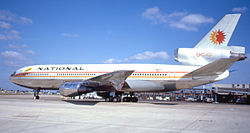
National Airlines has used the following aircraft and helicopters throughout its history :
In April 1979 the fleet consisted of 16 Boeing 727-100s, 24 Boeing 727-200s, 11 McDonnell Douglas DC-10-10s and 5 McDonnell Douglas DC-10-30s.
Incidents
- On September 13, 1945, a Lockheed 18 Lodestar ( aircraft registration number : NC33349 ) came off the track while landing at Tampa Airport . The machine was written off as a total loss.
- On October 9, 1945, the crew of a Lockheed Lodestar ( NC18199 ) lost visual contact with the runway on the final approach to Lakeland . The machine hit a lake behind the train, killing two passengers.
- On October 11, 1945, a Lockheed Lodestar ( NC15555 ) crashed after an engine failure while attempting an emergency landing at the Banana River Naval Air Station . All 16 inmates survived the incident.
- On January 14, 1947, a Douglas DC-4 ( N74685 ) burned down after a landing accident at Philadelphia International Airport ( Pennsylvania ). One crew member and six passengers were killed.
- On January 14, 1951, a Douglas DC-4 ( N74685 ) rolled over the end of the runway while landing at Philadelphia International Airport and immediately caught fire. Seven of the 28 inmates died, including one crew member.
- On February 11, 1952, a Douglas DC-6 (crashed N90891 ) after taking off from Newark Airport in a house in Elizabeth ( New Jersey ). 29 of the 63 occupants died in the accident. In addition, four other people were killed on the ground. The causes were an automatic adjustment of the propeller number 3 to reverse thrust, followed by the incorrect shutdown of the functioning engine number 4. This meant that the altitude could not be maintained; the machine crashed into the city.
- On February 14, 1953, a Douglas DC-6 ( N90893 ) crashed in the Gulf of Mexico after being structurally damaged while flying through a storm with severe turbulence . All 46 inmates lost their lives.
- On January 10, 1955, a Lockheed Lodestar ( N33369 ) came off the track when taking off from Sarasota . The aircraft was written off as a total loss.
- On October 20, 1956, a Lockheed Lodestar ( N33368 ) crashed while landing at Dale Mabry Field in Tallahassee . The aircraft was damaged beyond repair.
- On November 16, 1959, a Douglas DC-7B ( N4891C ) crashed on a flight from Tampa to New Orleans of unknown cause in the Gulf of Mexico. The plane, in which there were 42 people, had been leased from Delta Air Lines . Only nine bodies and some floating debris were found.
- On January 6, 1960, an explosive device exploded on board a Douglas DC-6B ( N8225H ), which was to carry out an additional flight from New York to Miami. The machine struck near the village of Bolivia ( North Carolina on). All 34 occupants, 29 passengers and five crew members were killed. A Boeing 707 rented by Pan Am was regularly used on this scheduled flight , but it was not available that day due to a broken cockpit window. As replacement aircraft, National Airlines provided a Lockheed L-188 and a Douglas DC-6 at short notice , on which the 105 passengers were distributed. The L-188 took off for Miami with 76 passengers, while the remaining 29 traveled with the downed DC-6.
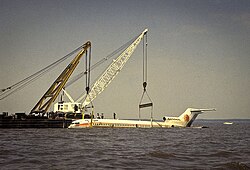
- On November 15, 1961, a National Airlines Douglas DC-6B ( N8228H ) taking off collided with a Northeast Airlines Vickers Viscount ( N6592C ) at Boston Airport . All occupants of the two aircraft survived the accident. Both machines were written off as total losses.
- On November 3, 1973, a McDonnell Douglas DC-10-10 ( N60NA ) suffered severe engine damage while cruising, with a turbine blade breaking through a cabin window. A passenger was sucked through the broken window as a result of the sudden drop in pressure . The pilots were able to make an emergency landing at Albuquerque International Sunport Airport.
- On May 8, 1978, the crew of a Boeing 727-235 (N4744) on approach to Pensacola fell below the minimum descent altitude and continued the descent for another 18 seconds after the ground proximity warning system first sounded . The machine hit the shallow water of Escambia Bay. Three passengers were killed (see also National Airlines flight 193 ) .
Trivia
- In the early 1970s, National Airlines launched a $ 9.5 million marketing campaign in which, among other things, flight attendants used the ambiguous slogan “Fly me” to advertise society in TV spots and on posters. In addition, the female cabin crew had to wear name tags such as “I'm Cheryl, Fly me” on their uniforms, which led to protests from the stewardesses. Women's associations called on those affected to sue their employers for sexism . One of these advertising posters inspired the British rock band 10cc for their song "I'm Mandy Fly Me" .
- Almost all National Airlines aircraft had a female baptismal name painted on the fuselage. This tradition began in February 1960 with the delivery of the first Douglas DC-8-21, which was named "Kathleen" .
- Between 1961 and the merger with Pan Am on January 7, 1980, 26 National Airlines aircraft were hijacked. In most cases, the kidnappers wanted to go to Cuba.
See also
Individual evidence
- ^ Flight International, May 6, 1971
- ^ Ed Coates' Civil Aircraft Photograph Collection
- ^ Scott Taylor Hartzell: Remembering St. Petersburg, Florida: More Sunshine City Stories . The History Press, Charleston 2006, ISBN 1-59629-122-2 .
- ^ Sarasota Herald Tribune, May 2, 1935.
- ↑ a b c d e f g h i j k l m n o National Sundowners, National Airlines History ( Memento from October 22, 2018 in the Internet Archive )
- ^ National Airlines, flight plan November 1937
- ↑ National Airlines, flight plan November 1938
- ^ Airline Timetable Images, National Airlines, cover sheet of the April 1940 flight plan
- ↑ a b National Sundowners, Stewardesses Who Flew In The 40's ( Memento from December 30, 2014 in the Internet Archive )
- ^ W. David Lewis: Eddie Rickenbacker: An American Hero in the Twentieth Century . The Johns Hopkins University Press, Baltimore 2005, ISBN 0-8018-8244-3 .
- ^ National Airlines, flight plan February 1945
- ↑ rzjets.net, Douglas DC-4 of National Airlines
- ^ National Airlines, January 1947 flight plan
- ↑ rz.jets.com, Douglas DC-6 of National Airlines
- ^ National Airlines, Douglas DC-6, NC90891 (c / n 43055)
- ^ Flight International, October 5, 1950
- ^ Flight International, May 25, 1951
- ^ Flight International, August 3, 1951
- ↑ rzjets.com, Convair CV-340 of National Airlines
- ↑ rzjets.com, Douglas DC-7 of National Airlines
- ↑ Flying Magazine. May 1954.
- ↑ George W. Cearley, Jr .: National, Airline of the Stars: An Illustrated History . George Cearley, 1985.
- ^ National Airlines, August 1954 flight plan
- ↑ rzjets.com, Lockheed L-1049 of National Airlines
- ^ Flight International, April 18, 1958
- ^ Jon Proctor, Mike Machat, Craig Kodera: From Props to Jets: Commercial Aviation's Transition to the Jet Age 1952-1962 . Specialty Press, North Branch 2010, ISBN 1-58007-146-5 .
- ↑ Ulrich Hoppe, Lockheed L-188 production list
- ↑ Planespotters, Douglas DC-8-21 of National Airlines
- ^ Flight International, November 5, 1964
- ^ Flight International, April 2, 1964
- ↑ jetphotos.net, Boeing 727-100, N4610
- ^ Flight International, September 21, 1967
- ↑ rzjets.com, National Airlines, Boeing 727, N4730
- ↑ rzjets.com, National Airlines, Boeing 747, N77772 and N77773
- ^ Flight International, June 8, 1972
- ^ Flight International, June 29, 1972
- ^ Flight International, March 26, 1977
- ↑ JP airline-fleets international 76
- ^ Flight International, August 12, 1978
- ^ Flight International, September 16, 1978
- ^ Flight International, May 5, 1979
- ^ Flight International, May 12, 1979
- ^ Flight International, July 21, 1979
- ^ Flight International, January 12, 1980
- ↑ Flight International, various issues
- ↑ National Airlines fleet overview
- ↑ JP airline markings, JP airline-fleets international, various years
- ^ Flight International, April 28, 1979
- ^ Aviation Safety Network, September 13, 1945
- ^ Aviation Safety Network, October 9, 1945
- ^ Aviation Safety Network, October 11, 1945
- ^ Aviation Safety Network, January 14, 1947
- ↑ accident report DC-4 N74685 , Aviation Safety Network (English), accessed on 15 January 2018th
- ↑ Air-Britain Archive: Casualty compendium (English), June 1994, pp. 94/54.
- ↑ accident report DC-6 N90891 , Aviation Safety Network (English), accessed on 21 August 2017th
- ^ Aviation Safety Network, February 14, 1953
- ^ Aviation Safety Network, January 10, 1955
- ^ Aviation Safety Network, October 20, 1956
- ^ Aviation Safety Network, November 16, 1959
- ^ Aviation Safety Network, January 6, 1960
- ^ Aviation Safety Network, November 15, 1961
- ^ Aviation Safety Network, November 3, 1973
- ↑ accident report B 727-200 N4744 , Aviation Safety Network (English), accessed on 5 February of 2019.
- ^ Carrie N. Baker: The Women's Movement Against Sexual Harassment . Cambridge University Press, 2007, ISBN 0-521-70494-4 .
- ↑ Genius, 10cc - I'm Mandy, Fly Me
- ^ Aviation Safety Network, National Airlines Incidents